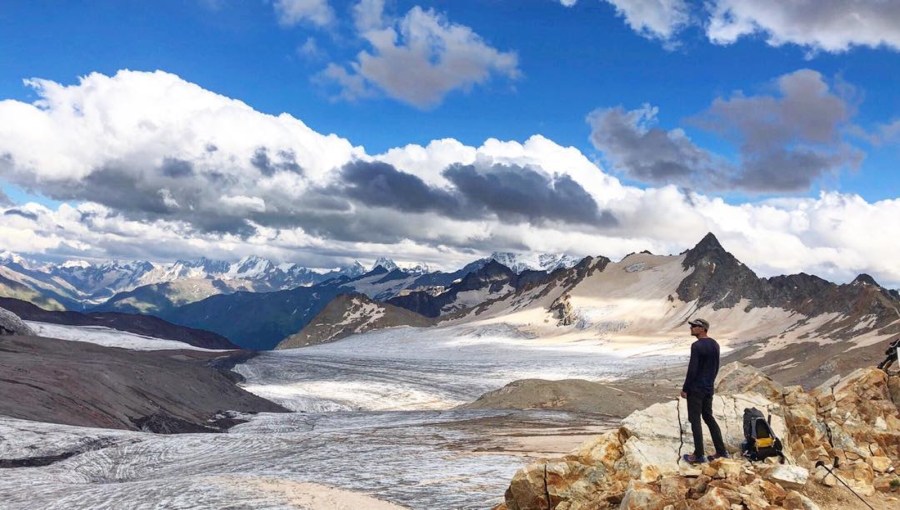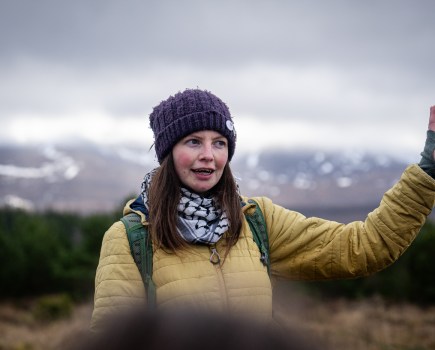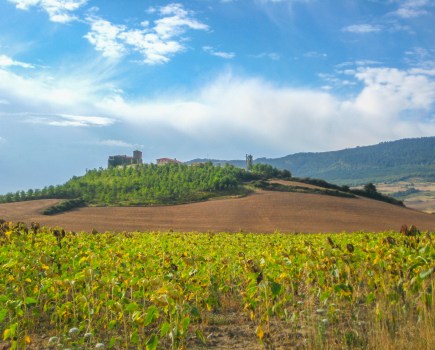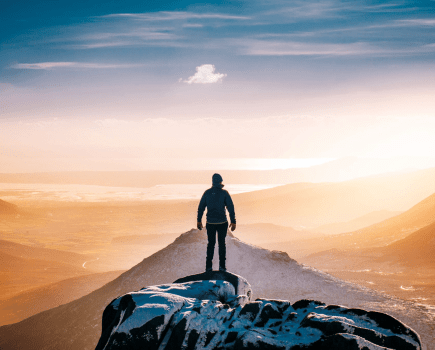“In Russia, the police kept an uncomfortably close eye on me wherever I went. They seemed pretty suspicious of my presence and it was hard to convince them that I’d just come for a walk!”
This week it’s our pleasure to introduce Richard Hartfield, a long-distance backpacker who has completed some big and impressive long-distance backpacking routes over the past few years.
Alex Roddie: Please introduce yourself. Who are you and what do you do?
Richard Hartfield: “Hi! I’m Richard. I do long-distance backpacking, fell running and rock climbing, and I’m also training to become a mountain leader. I enjoy making my own backpacking routes through mountains that are a bit off the radar compared to most walking destinations. I’ve crossed the Greater Caucasus Mountains through Russia, Georgia and Azerbaijan, and I’ve walked in places like Romania, Bulgaria, Albania, Kosovo and Montenegro.”
AR: You’ve completed some big and impressive long-distance backpacking routes over the past few years. What are your motivations for this ambitious kind of hiking, and how did you get into it?
RH: “I think my biggest motivation is just that feeling of exploring new places, and spending lots of time outside on my feet, covering distance. There’s something about looking for somewhere new to camp at the end of a long day’s walk, with everything you need on your back, that I find really liberating and exciting. I do a lot of fell running and rock climbing back home, and so I probably approach backpacking in the mountains as a combination of these things; I like travelling fast and light, going off trail, and I love the physical challenge of navigating safely through steeper and more tricky terrain.
“It’s nice to know that wherever you go in the world, you can always find new friends and places that feel welcoming”
“I find backpacking really immersive; the simplicity of walking and camping day after day after day makes me feel so much more connected to myself and to the world around me. This feeling stays with me even after I get home. It reminds me what’s really important, and how beautiful the world is. It also encourages me to get out into my local countryside as well, and find new ways to have smaller outdoor adventures on a day-to-day basis.
“I’ve trended towards more difficult and unknown destinations over the last few years because I like to challenge myself and explore places that I’m unfamiliar with. Not having a guidebook makes you learn a lot about how to plan and figure things out for yourself instead. I’ve really enjoyed that.
“Backpacking in more remote and far-flung places is also a great way to experience new cultures from an angle that most tourists don’t ever get to see. I’ve met people living out in the middle of nowhere who’ve shown such incredible kindness and generosity towards me. In Albania, an elderly lady welcomed me into her little house to meet her entire family. They gave me dinner, asked me all about life back home in the UK, and invited me to stay for the night. In Azerbaijan, a family living in a remote village looked after me for two days when I was sick. Then afterwards, they guided me along a path through the forests above their home so that I could get back onto my route. Experiences like that reinforce my faith in humanity! It’s nice to know that wherever you go in the world, you can always find new friends and places that feel welcoming.”
AR: What has the learning curve been like?
RH: “I’ve tried to gradually increase the difficulty of the backpacking trips that I’ve made. It started about six years ago with a solo, week-long hike through part of the Cevennes National Park in southern France. I followed waymarked GR trails from campsite to campsite, eating lots of nice cheese along the way. It all went pretty well, except for some blisters on day four!
“I found that I really enjoyed the rocky and more remote parts of that hike the most. In the years since, I’ve backpacked in the French Alps, done the Pyrenean Haute Route, and explored mountain ranges across the Balkans and Eastern Europe. This all led up to my trip last year, when I tried to hike across the Greater Caucasus Mountains, which was significantly more difficult.”
AR: Tell us about your crossing of the Greater Caucasus Mountains. How long were you hiking for, and what were the major challenges you faced on a daily basis? Which countries did you visit?
RH: “I spent two months trying to hike alone from the Black Sea to the Caspian Sea. I went through parts of Russia, Georgia and Azerbaijan. Walking the complete journey was impossible because of the difficult terrain, strictly policed border zones, and a lack of mapped paths to follow. Because of these issues, I ended up having to take transport between some sections, and sometimes walked on roads lower down, which wasn’t always very appealing.
“The terrain also threw curveballs at me each day, with lots of remote, trailless sections through deep forests, tricky mountain passes and dangerous rivers”
“The biggest challenge that I faced was the endless uncertainty of not knowing whether I’d be able to find trails to follow, or whether I’d be given permission to walk in certain areas. I set off with only fragments of a route mapped out, and permits for some of the republics in the Russian North Caucasus. I was lucky to have found someone from each country who was kindly willing to offer me some advice via telephone whilst I was out there, but I still had to try to figure out most things as I went along. I relied a lot upon the help of locals that I met along the way. People were incredibly kind to me. They often showed me the paths linking their village to the next one, and nearly aways invited me in for food or somewhere to sleep before they’d let me go anywhere.
“Frustratingly, I was denied access to many areas because of the strict border zone regulations between each country. In Russia, the police kept an uncomfortably close eye on me wherever I went. They seemed pretty suspicious of my presence and it was hard to convince them that I’d just come for a walk! It got quite intimidating at times. The terrain also threw curveballs at me each day, with lots of remote, trailless sections through deep forests, tricky mountain passes and dangerous rivers.”
AR: What were the high and low points of your journey?
RH: “One of lowest points was at the beginning in Russia, when for about a week I couldn’t even start my walk from Sochi on the Black Sea coast, because I kept getting refused access to the mountains within the border zone next to Abkhazia. Then I was hassled by the police as I tried to move eastwards to pick up my route further along. I started to feel pretty overwhelmed by the whole thing, and wondered exactly what I’d let myself in for! In the end, I decided that I needed to confront my fears and keep pushing onwards, which became something of a defining attitude for the rest of my trip.
“Soon afterwards, I managed to finally rejoin my route in the Republic of Karachay-Cherkessia, and discovered that the Russian North Caucasus is one of the most beautiful places in the world to hike through. The mountains there felt so wild and pristine. The huge valleys, untouched forests, and glaciated peaks were absolutely stunning. The people living there were also unbelievably kind and welcoming towards me. Even though I kept having issues with police and border guards, it only added to the experience – it felt adventurous and exciting to be a foreign visitor travelling alone in a politically unstable part of Russia that really isn’t used to having lone Western visitors wandering around. I’ll never forget it.
“Azerbaijan and Russia are a completely different story to Georgia because so many areas are deemed off limits by the authorities. This also means that hiking infrastructure is non-existent”
“One of my high points during the trip was being saved from a massive thunderstorm on a remote mountain plateau in the Russian republic of Kabardino-Balkaria by Boris, a Balkar shepherd. I was running away from the lightning, feeling pretty terrified, when he suddenly appeared out of the mist and rain, riding a horse and wearing aviator sunglasses. He invited me to stay in his hut, which he’d built himself next to a glacier. He put the radio on, cooked up a huge pot of borscht, and made me endless cups of chai tea until we went to bed. Experiences like that make it all worthwhile!”
AR: Any words of advice for someone hoping to follow in your footsteps?
RH: “I’d encourage most people to look at hiking in Georgia first because it’s the most accessible country in the Greater Caucasus. The Georgian government seems to be starting to encourage the development of hiking tourism and hiking infrastructure. This has been helped by the brilliant Transcaucasian Trail project. There’s now a growing network of well-mapped trails in places like Svaneti and Tusheti. Many villages also provide food and accommodation to hikers. Like everywhere in the Caucasus, Georgia is a beautiful country, full of culture and steeped in ancient history.
“As a personal tip, I’d recommend any readers looking for a guided trip in Georgia to contact Devi Asmadiredja on her website Devi Adventure. She’s a really knowledgable local guide who speaks great English, is really funny, and offered lots of help to me during my journey.
“Azerbaijan and Russia are a completely different story to Georgia because so many areas are deemed off limits by the authorities. This also means that hiking infrastructure is non-existent. If you want to hike in these countries, you’ll have to be prepared to go through the added logistical nightmare of acquiring permits and visas, and generally be a lot more self-sufficient. Another option would be to go to Russia or Azerbaijan with a local outdoor tourism operator, such as Caucasus Explorer, Caucasus Voyage Club, or Camping Azerbaijan, all of whom run guided excursions and treks through many of the areas that I visited, and will handle all of the logistical legwork for you. Caucasus Explorer in particular are now using sections of the route that I walked as part of a much longer trekking/jeep tour that crosses the entire North Caucasus, continuing on through Chechnya and Dagestan.”
AR: How do you select gear for use on these challenging long-distance routes in big mountain areas?
RH: “On longer trips, versatility and reliability are more crucial, because you’re facing a wider range of weather and terrain, and things are also getting used a lot harder. I‘ve got a small amount of gear which has always worked well for me in summer alpine conditions. It’s lighter than what many would carry, but everyone has different levels of comfort. You have to find out what works best for you by getting out there and trying things.
“The UK really has so much to offer, and that’s something that I’ve perhaps overlooked a bit in the past, because going overseas is always so tempting”
“When I plan a trip, I’ll start by trying to determine the precise weather and terrain conditions that I’ll be encountering, and then I’ll adjust my core setup accordingly. As I’m doing this, I’ll take things out and test them on shorter trips closer to home to make sure that I can rely on them. And if something isn’t broken, don’t fix it! When I found a pair of shoes that worked really well for me on the Pyrenean Haute Route, I immediately got home and bought four more pairs as soon as they went on sale. Now I’ve not had to worry about finding the right shoes again for several years. That means I get to spend more time looking at maps instead!
“If you’re very new to backpacking, and don’t know where to start with getting the necessary gear, I’d recommend reading books or articles by Chris Townsend and Andrew Skurka. They both offer very honest advice, and have an incredible amount of backpacking experience.”
AR: What kind of outdoor activities do you like to get up to closer to home?
RH: “I do a lot of fell running in the Charnwood Forest at home here in Leicestershire. I’m also into rock climbing, so I often head out to the Peak District to climb on gritstone. Apart from that, I’m now doing my mountain leader qualifications, which has given me a great excuse to spend more time exploring Snowdonia and the Lake District. I love scrambling in particular. The UK really has so much to offer, and that’s something that I’ve perhaps overlooked a bit in the past, because going overseas is always so tempting.
“I’m also spending a lot of time lately editing all of the video footage from my Caucasus hike. It’s a really long process for me, but it’s a nice new challenge learning to how to share some of the landscapes and experiences from my journey using video.”
AR: Anything you can tell us about future planned trips?
RH: “The list of hikes that I want to do never stops growing. Some of the bigger ones in the pipeline are the Greater Patagonian Trail, the Great Himalaya Trail, plus lots of things in the US such as the Hayduke and the Sierra High Route. But nearly everything that I’ve done so far has been solo, and long-distance. This year, I’m starting to wonder if I might try focusing a bit more on some shorter, more varied excursions instead. Maybe I’m still recovering from last summer’s antics.”
AR: Where can our readers follow your adventures?
RH: “I mostly use instagram to show what I’m up to (instagram.com/richhartfield). I’ve also got a Youtube channel, where I post vlogs from some of my hiking trips (youtube.com/richhartfield). I’ve got a new film on the way from my Greater Caucasus hike which I’m really excited about! I’ve also got a website at www.richardhartfield.com.”
Header image © Richard Hartfield









